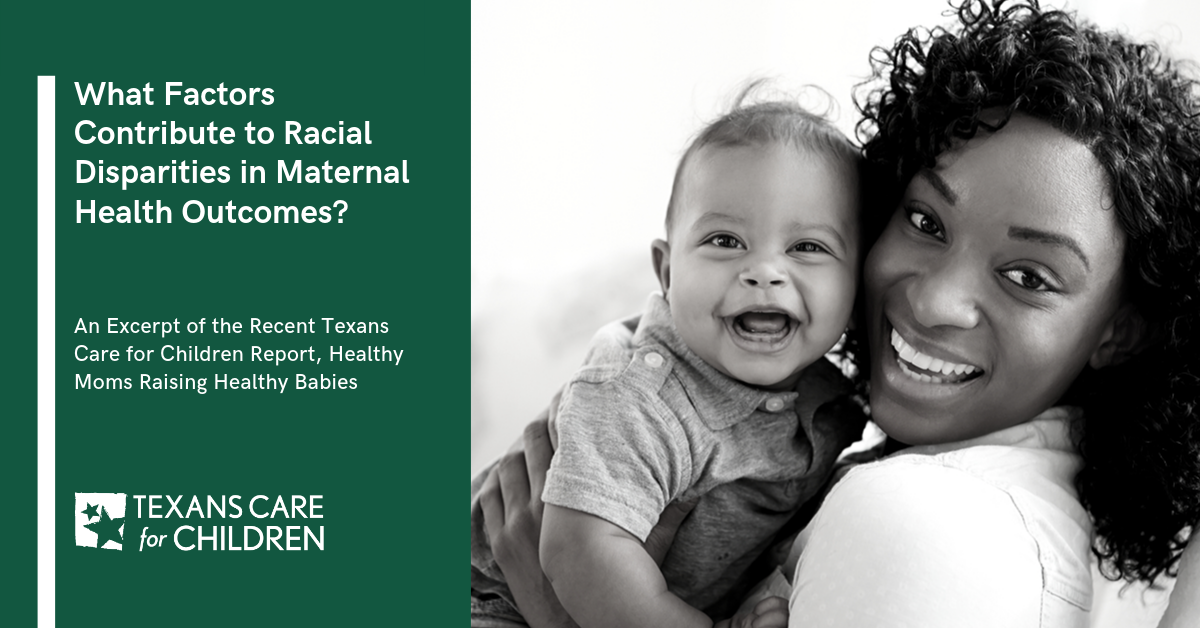An Excerpt of the Recent Texans Care for Children Report, Healthy Moms Raising Healthy Babies: Central Texas and Statewide Challenges and Opportunities to Support Maternal Behavioral Health During the First Year After Childbirth

Health and health care do not exist in a vacuum. The health of families and whole populations are shaped by a combination of individual, health system, community, and structural variables, many of which are interrelated. These factors affect mothers of all backgrounds and from all communities in Texas.
However, the data make clear that the health risks to Black mothers and infants are particularly high. While an in-depth examination of the factors that contribute to these higher health risks is beyond the scope of this project, this document provides an introduction to some of the factors that contribute to racial disparities and disproportionality in maternal and infant health.
Implicit biases in our health care system can affect the quality of health care provided, decision making, and how health programs are carried out.
Research shows that implicit biases — subconscious, involuntary assumptions — affect our “feelings and attitudes about other people based on characteristics such as race, ethnicity, age, and appearance.” Those biases include implicit racial biases, the unintentional negative assumptions about Black people, resulting from centuries of racist ideas, that can affect the actions of even well-intentioned people.
As health care professionals evaluate and communicate with Black patients, those invisible biases can affect decision making and the quality of health care. Four out of five studies on the subject “found evidence of implicit race bias among clinicians,” according to an analysis by the Institute for Urban Policy Research & Analysis (IUPRA) at the University of Texas at Austin. Beyond individual interactions between health care professionals and patients, implicit biases can also affect the systems-level decision making of policymakers and program officials.
The first step to addressing implicit biases and their consequences is for individual health care providers and leaders to recognize that they exist. It is also important to address implicit bias through training, collection and analysis of data, and efforts to directly counteract the effect of biases.
Chronic stress, including the physical toll of stress related to structural racism, increases health risks for mothers and babies.
In recent years, researchers have identified a closer link between chronic stress and physical health than previously known. The persistent, constant coping with acute and chronic stressors impact the body on a physiological level and can have a profound effect on health. The link between stress exposure and physical health has been referred to as “weathering” and allostatic load. Allostatic load describes the cumulative physiological impact of chronic stressors experienced over a person’s lifetime. Research on weathering reveals chronic stress during pregnancy and exposure to stress hormones over the life course has a “wear and tear” effect on mothers and can cause physical harm and health risks to mother and baby. Research shows that the effects of weathering or allostatic load affect Black Americans — regardless of socioeconomic or educational background — more than any group in the form of negative health outcomes.
Reflecting this and other research, many experts now believe that the physical toll of stress related to structural racism provides part of the explanation for racial disparities in birth outcomes. For instance, an atmosphere of societal and systemic racism can create a kind of toxic physiological stress over time, increasing the risk of conditions like hypertension and preeclampsia, which contribute to pregnancy complications or maternal and infant death.
Discrimination, both past and present, negatively affects social determinants of health — such as housing, food scarcity, and education, among others.
Health care experts are increasingly focused on “social determinants” of health. The CDC, for example, notes that social determinants — such as unstable housing, low income, unsafe neighborhoods, or substandard education — negatively affect health outcomes.
While social determinants of health are influenced by income, they are also influenced by race in a way that can place higher income Black families at greater risk of poor health, particularly when combined with implicit bias and the other factors discussed in this section of our report.
For many Black people today, social determinants of health have been affected by multiple generations of discriminatory policies and practices regarding housing, employment, criminal justice, education, and other areas. The staggering wealth gap between Black and White families today, which in part reflects the way parents and grandparents are able to accumulate and pass financial assets down to their children, underscores the way discriminatory policies and practices of recent generations continue to affect current generations.
Lack of access to health insurance disproportionately affects people of color and limits the ability to manage health conditions before and after pregnancy.
As the Texas Maternal Mortality and Morbidity Task Force’s recommendation highlights, access to primary, behavioral, and specialty care before and after pregnancy is the most effective way to manage health conditions (such as high blood pressure or diabetes) before they get worse or become harmful for mother and baby. However, access to health care is limited for women who are uninsured.
In Texas, Black and Hispanic women are more likely to be uninsured than White women. Seventeen percent of nonelderly Black adults in Texas, 29 percent of nonelderly Hispanic adults, and 12 percent of nonelderly White adults in the state were uninsured in 2017.
Recent research found that states that offer Medicaid insurance to cover low-wage adults who do not have insurance through their job experienced a decrease in disparities for Black families with respect to maternal mortality, infant death, preterm birth, and low birth weight babies. Specifically:
- Analysis of data from 2010 to 2016 found that infant deaths have declined across most states, but the decline was more than 50 percent greater in states that offer health coverage before, during, and after pregnancy — with the decline in infant deaths greatest among Black infants.
- Research found that coverage for low-wage workers before, during, and after pregnancy was associated with “significant improvements in disparities for black infants relative to white infants for the four outcomes studied: preterm birth, very preterm birth, low birth weight, and very low birth weight.”
CLICK HERE FOR A PDF VERSION OF THIS EXCERPT OF OUR REPORT
Click here for our original report on Healthy Moms Raising Healthy Babies



